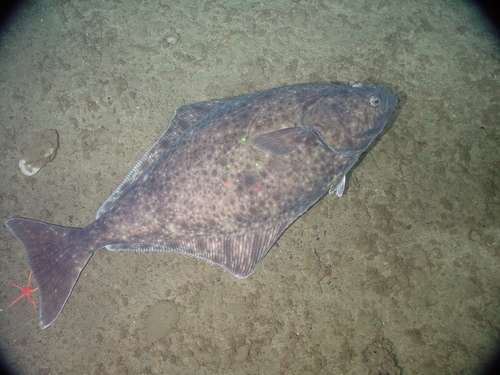|
| Common Animals Fish Mushrooms Flora |
Hippoglossus stenolepis |
June: Post-spawning. Flounder recovers and continues hunting in coastal waters.
Traditionally harvested in Alaska, Canada, and Russia Important in the diet of Northern peoples
One of the largest flatfishes: up to 200 kg Prefers cold waters of the North Pacific Predator feeding on fish, mollusks, and crustaceans
Bottom fishing with live bait or fish chunks Trolling with heavy lures Deep-sea fishing from a boat
Large specimens are active in spring and summer Best bite at 100–300 meters depth Better caught in calm currents and cloudy weather
19 June 2025 The average bite
20 June 2025 The average bite
21 June 2025 Bad bite
22 June 2025 Bad bite
23 June 2025 Bad bite
24 June 2025 The average bite
25 June 2025 The average bite
20 June 2025 The average bite
21 June 2025 Bad bite
22 June 2025 Bad bite
23 June 2025 Bad bite
24 June 2025 The average bite
25 June 2025 The average bite
Meat is dense, white, nearly boneless Large fish — easy to fillet in sections Thick skin, often removed before cooking
Fillet: Baking, frying, grilling, smoking
Belly: Fish soup, steaks
Belly: Fish soup, steaks
Grilled Halibut Steak (Grilling)
Firm meat holds marinade well
Firm meat holds marinade well
1. Marinate in lemon, garlic, and olive oil.
2. Grill 4–6 minutes per side.
3. Serve with vegetables or potatoes.
2. Grill 4–6 minutes per side.
3. Serve with vegetables or potatoes.
Baked Halibut (Baking)
Suitable for large portions
Suitable for large portions
1. Season with salt, pepper, and herbs.
2. Bake at 180°C for about 25 minutes.
3. Serve with tartar or cream sauce.
2. Bake at 180°C for about 25 minutes.
3. Serve with tartar or cream sauce.
Smoked Halibut (Smoking)
Dense meat absorbs smoke flavor well
Dense meat absorbs smoke flavor well
1. Salt the fish for 12 hours.
2. Smoke at 80–100°C for 2–3 hours.
3. Cool and serve with bread or potatoes.
2. Smoke at 80–100°C for 2–3 hours.
3. Cool and serve with bread or potatoes.
 United States · Texas · Hays
United States · Texas · Hays